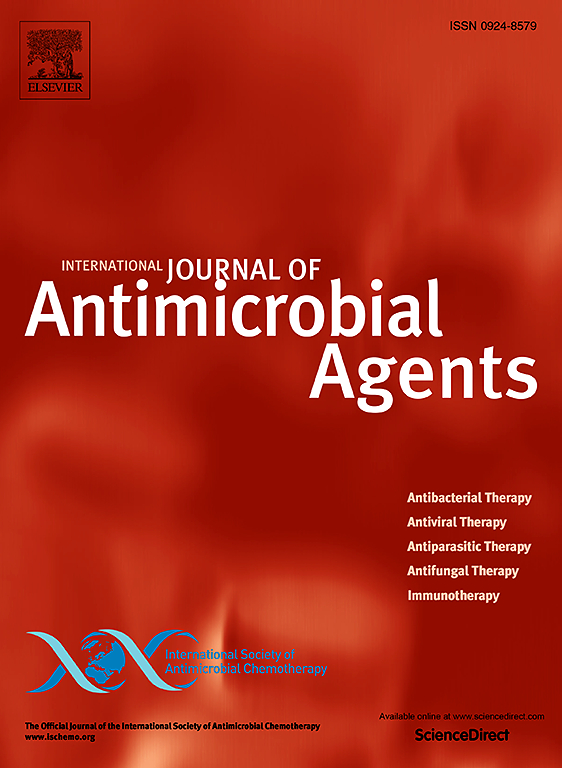Effectiveness of short treatment duration for carbapenemase-producing Enterobacterales in bloodstream-infections: A retrospective cohort study
IF 4.9
2区 医学
Q1 INFECTIOUS DISEASES
International Journal of Antimicrobial Agents
Pub Date : 2024-09-02
DOI:10.1016/j.ijantimicag.2024.107318
引用次数: 0
Abstract
Objective
We analyse the effectiveness of short courses of adequate treatment in patients with episodes of carbapenemase-producing Enterobacterales bloodstream-infections (CPE-BSI).
Methods
Patients with first monomicrobial CPE-BSI episodes who received ≥72 h of appropriate treatment from 2014–2022 were selected. Detection of CPE was established on the basis of phenotypic antibiogram and confirmation by PCR and/or immunochromatographic methods. Patients were classified in short treatment group (STG) those who received 3–10 days of appropriate treatment, and long treatment (LTG) those receiving >10 days. Unfavourable outcome consisted in a composite of global 30-day mortality and/or persistent bacteremia and/or recurrent bacteremia. Inverse probability of treatment weighting (IPTW) analysis was performed to compare the outcome between the two study groups.
Results
We included 105 CPE-BSI episodes: 99 were caused by OXA-48-like, 4 VIM and 2 KPC carbapenemases. Thirty-nine patients (37.1%) were included in the STG and 66 (62.9%) in LTG. The STG group presented frequent treatment with ceftazidime-avibactam (43.6% vs. 24.2%, P = 0.03) and lower in-hospital stay (21 days vs. 32 days, P = 0.02). Overall, 28 patients (26.7%) presented unfavourable outcome: IPTW analysis showed no differences in the outcome between STG to LTG groups (24.2% vs. 30.8%, weighted-risk difference 6.6%, P = 0.44). Patients with unfavourable outcome presented more frequently source other than urinary-biliary (46.4% vs. 23.4%, P = 0.02), received less frequently ceftazidime-avibactam (14.3% vs. 37.7%, P = 0.02) and presented frequently with absence of source control when indicated (28.6% vs. 13.0%, P = 0.06).
Conclusions
Short treatment durations for CPE-BSI episodes may be effective, as long as they are appropriate and source control is performed.
短期治疗血流感染中产碳青霉烯酶肠杆菌的有效性:一项回顾性队列研究。
目的我们分析了短期适当治疗对产碳青霉烯酶肠杆菌血流感染(CPE-BSI)患者的疗效:方法: 选取2014-2022年间首次发生单微生物CPE-BSI且接受适当治疗≥72小时的患者。CPE 的检测以表型抗生素图为基础,并通过 PCR 和/或免疫层析方法进行确认。接受 3-10 天适当治疗的患者被分为短期治疗组(STG),接受 10 天以上治疗的患者被分为长期治疗组(LTG)。不良结局包括 30 天内的总死亡率和/或持续菌血症和/或复发性菌血症。为了比较两个研究组之间的结果,我们进行了逆概率治疗加权(IPTW)分析:我们共纳入了 105 例 CPE-BSI:99 例由 OXA-48 类、4 例 VIM 和 2 例 KPC 碳青霉烯酶引起。39名患者(37.1%)被纳入STG组,66名患者(62.9%)被纳入LTG组。STG组经常使用头孢他啶-阿维菌素治疗(43.6% 对 24.2%,P=0.03),住院时间较短(21 天对 32 天,P=0.02)。总体而言,28 名患者(26.7%)出现了不良预后:IPTW分析显示,STG组与LTG组的预后无差异(24.2% vs. 30.8%,加权风险差异为6.6%,P=0.44)。疗效不佳的患者更多地出现尿胆以外的感染源(46.4% vs. 23.4%,p=0.02),接受头孢他啶-阿维菌素治疗的比例较低(14.3% vs. 37.7%,p=0.02),在有指征的情况下经常出现未进行感染源控制的情况(28.6% vs. 13.0%,p=0.06):结论:对 CPE-BSI 病例进行短期治疗可能是有效的,只要治疗得当并进行了病源控制。
本文章由计算机程序翻译,如有差异,请以英文原文为准。
求助全文
约1分钟内获得全文
求助全文
来源期刊
CiteScore
21.60
自引率
0.90%
发文量
176
审稿时长
36 days
期刊介绍:
The International Journal of Antimicrobial Agents is a peer-reviewed publication offering comprehensive and current reference information on the physical, pharmacological, in vitro, and clinical properties of individual antimicrobial agents, covering antiviral, antiparasitic, antibacterial, and antifungal agents. The journal not only communicates new trends and developments through authoritative review articles but also addresses the critical issue of antimicrobial resistance, both in hospital and community settings. Published content includes solicited reviews by leading experts and high-quality original research papers in the specified fields.

 求助内容:
求助内容: 应助结果提醒方式:
应助结果提醒方式:


